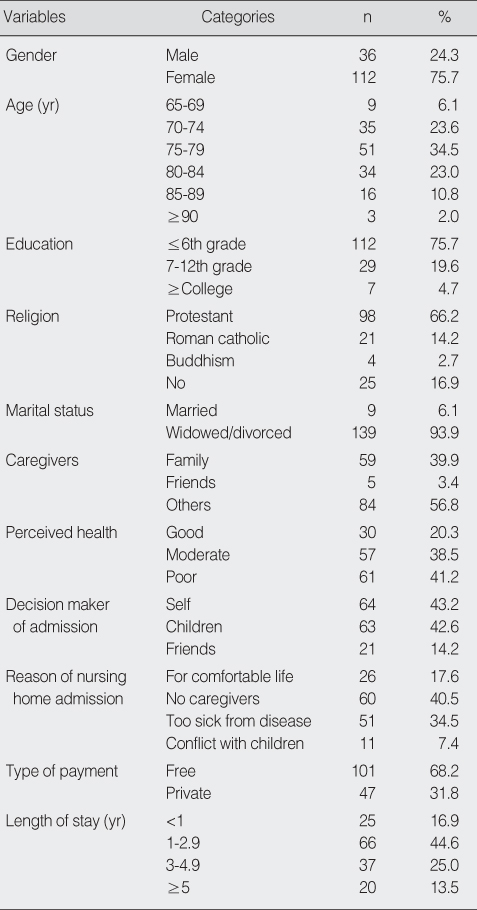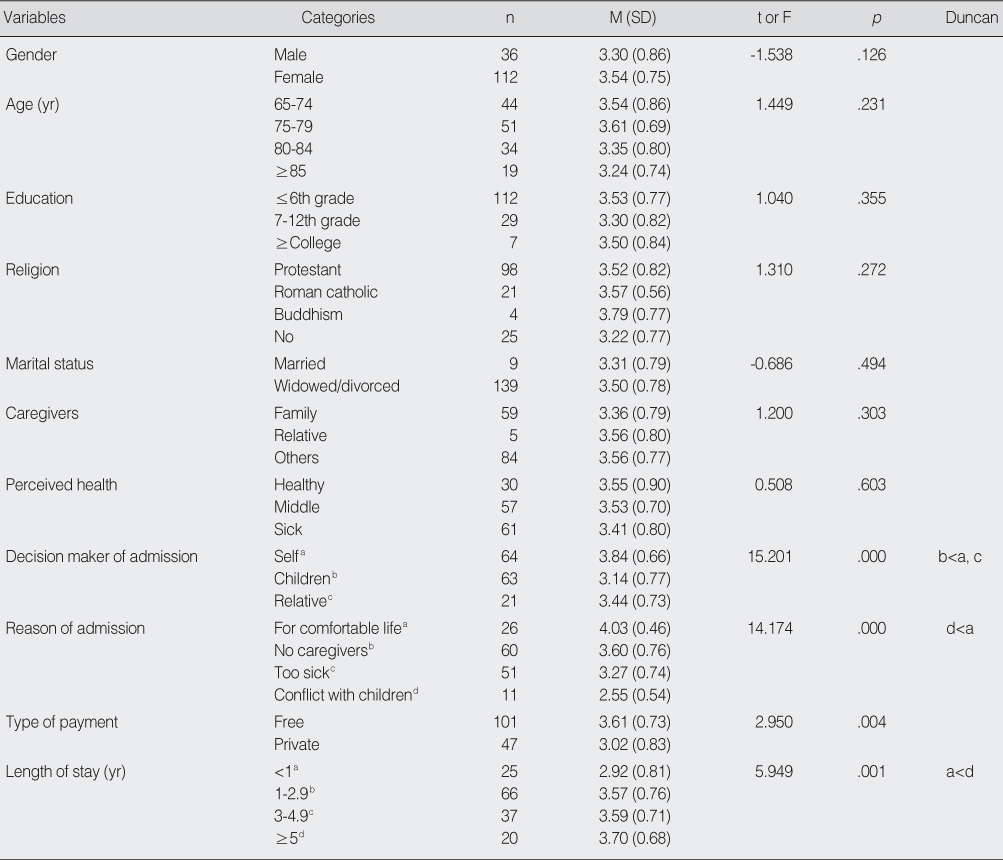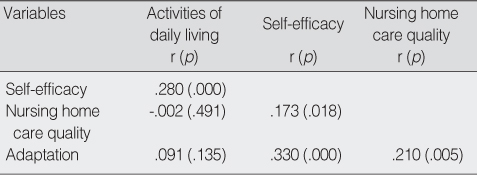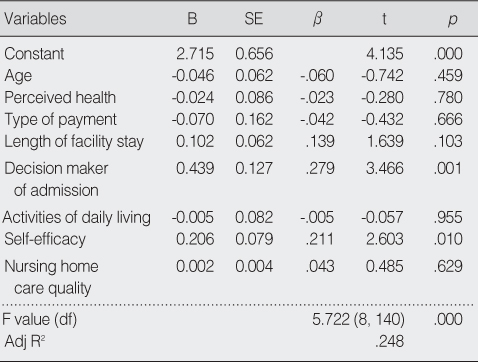Articles
- Page Path
- HOME > J Korean Acad Nurs > Volume 39(2); 2009 > Article
-
Original Article
- Predictors of Facility Adaptation in Nursing Home Residents
- Hyekyung Lee, Hyang-Yeon Lee, Jia Lee
-
Journal of Korean Academy of Nursing 2009;39(2):177-185.
DOI: https://doi.org/10.4040/jkan.2009.39.2.177
Published online: April 28, 2009
1Researcher, College of Nursing Science, Kyung Hee University, Seoul, Korea.
2Professor, College of Nursing Science, East-West Nursing Research Institute, Kyung Hee University, Seoul, Korea.
3Assistant Professor, College of Nursing Science, East-West Nursing Research Institute, Kyung Hee University, Seoul, Korea.
- Address reprint requests to: Lee, Jia. College of Nursing Science, Kyung Hee University, 1 Hoegi-dong, Dongdaemun-gu, Seoul 130-701, Korea. Tel: 82-2-961-0894, Fax: 82-2-961-9398, leejia@khu.ac.kr
• Received: September 23, 2008 • Accepted: February 11, 2009
Copyright © 2009 Korean Society of Nursing Science
Abstract
-
Purpose
- The purposes of this study were to examine the relationships among activities of daily living, self-efficiency, nursing home care quality and nursing home adaptation, and to identify the influencing factors of nursing home adaptation in nursing home residents.
-
Methods
- The study employed a descriptive correlational design. The data were collected from 148 older adults without dementia by interview from six nursing homes in three cities from February 1, 2008 to February 28, 2008.
-
Results
- Levels of nursing home adaptation in older adult residents were different by type of decision maker of nursing home admission, reason of nursing home admission, type of payment and length of nursing home stay. The nursing home adaptation was significantly correlated with self-efficiency and nursing home care quality. The strongest predictor of nursing home adaptation was type of decision maker of nursing home admission followed by the self-efficiency.
-
Conclusion
- The study suggested that during the decision making period of nursing home admission, older adults should have enough time and careful considerations of their families to decide by themselves in positive ways. Nursing home staff should be able to identify reasons of nursing home admission and demands or expectations of older adults and their families.
- 1. Brooke V. How elders adjust. Geriatric Nursing. 1989;10(2):66–68.ArticlePubMed
- 2. Choi HE. A study on the activities of daily living and satisfaction of the resident's paid welfare facilities. 2002;Seoul, Chung Ang University. Unpublished master's thesis.
- 3. Choi JS. Comparative study on health state of the aged resident in free of charged institution. 1992;Seoul, Kyung Hee University. Unpublished master's thesis.
- 4. Erdfelder E, Faul F, Buchner A. GPOWER: A general power analysis program. Behavior Research Methods, Instruments, & Computers. 1996;28:1–11.ArticlePDF
- 5. Glenn S. Information and communication technologies (ICT) in nursing education: Is there a need for a more philosophical analysis? Nurse Education Today. 2002;22:99–101.ArticlePubMed
- 6. Haight BK. Suicide risk in frail elderly people relocated to nursing homes. Geriatric Nursing. 1995;16:104–107.ArticlePubMed
- 7. Harrington C, Mullan J, Woodruff LC, Burger SG, Carrillo H, Bedney B. Stakenholders' opinions regarding important measures of nursing home quality for consumers. American Journal of Medical Quality. 1999;14:124–132.PubMed
- 8. Jeong JY. A phenomenological study on the adaptation experience on nursing home admission of senior patients. 2006;Busan, Catholic University of Pusan. Unpublished master's thesis.
- 9. Johnson BD, Stone GL, Altmaier EM, Berdahl LD. The relationship of demographic factors, locus of control and self-efficacy to successful nursing home adjustment. The Gerontologist. 1998;38:209–216.ArticlePubMed
- 10. Jorn MH, Hong GP, Lee KH. A study on the effects of environmental changes by relocation to daily activity of elderly with dementia. Journal of the Architectural Institute of Korea. 2006;22:107–114.
- 11. Kaisik BH, Ceslowitz SB. Easing the fear of nursing home placements: The value of stress inoculation. Geriatric Nursing. 1996;17:182–186.Article
- 12. Kim SK, Lee S, Lee HW. The difference of physical self-efficacy on sports events and various characters of participants. Journal of Korean Society for the Study of Physical Education. 2002;7:104–113.
- 13. Kim YK. A study on the influence factors related to health status and life satisfaction of the elderly accommodated in welfare facility. 2008;Daegu, Keimyung University. Unpublished master's thesis.
- 14. Korea Ministry of Health and Welfare. National status of elder care facilities 2008. 2008;Seoul, Author.
- 15. Korea National Statistical Office. 2007 Statistics on the aged. 2007;Seoul, Author.
- 16. Laughlin A, Parsons M, Kosloski KD, Bergman-Evans B. Predictors of mortality: Following involuntary interinstitutional relocation. Journal of Gerontological Nursing. 2007;33(9):20–26.Article
- 17. Lee GE. A grounded theory approach to the adjustment process of the institutionalized elderly: The control of reluctance. Journal of Korean Academy of Nursing. 2002;32:624–632.ArticlePDF
- 18. Lee GE. Scale development of free nursing home-adjustment for the elderly. Journal of Korean Academy of Nursing. 2007;37:736–743.ArticlePubMedPDF
- 19. Lee J. Validity and reliability of the Korean version of the observable indicators of Nursing Home Care Quality Evaluation Instrument. Journal of Korean Academy of Nursing. 2008;38:474–482.ArticlePubMed
- 20. Lee SK. A study on relationships among activities of daily living, self-efficacy and life satisfaction in nursing home elders. 2007;Seoul, Kyung Hee University. Unpublished master's thesis.
- 21. Mahoney FI, Barthel DW. Functional evaluation: The Barthel Index. Maryland State Medical Journal. 1965;14:61–65.Article
- 22. Mosher-Ashley PM, Lemay EP. Improving residents' life satisfaction. Nursing Homes. 2001;50:50–54.
- 23. Munro BH. Munro BH. Regression. In: Statistical methods for health care research. 2000;Philadelphia, PA, Lippincott Williams & Wilkins. 246–286.
- 24. Oh H.S. Health promotion and quality of life in Korean women with arthritis. Journal of Nurses Academic Society. 1993;23:617–630.
- 25. Park JH. A Qualitative research about institutional adaptation of the elderly person in free asylum for the aged. 2006;Seoul, Sungkonghoe University. Unpublished master's thesis.
- 26. Rantz MJ, Zwygart-Stauffacher M, Mehr DR, Petroski GF, Owen SV, Madsen RW, et al. Field testing, refinement, and psychometric evaluation of a new measure of nursing home care quality. Journal of Nursing Measurement. 2006;14:129–148.ArticlePubMed
- 27. Reinardy JR. Relocation to a new environment: Decisional control and the move to a nursing home. Health & Social work. 1995;20:31–38.Article
- 28. Sherer M, Maddux JE. The self-efficacy scale: Construction and validation. Psychological Reports. 1982;51:663–671.ArticlePDF
- 29. Shin SY. The study on the impact of decision-making process on the adjustment of relocation to a nursing home in the elderly. Journal of Welfare for the Aged. 2002;18:111–129.
REFERENCES
Figure & Data
REFERENCES
Citations
Citations to this article as recorded by 

- Psychometric properties of the Chinese version of the Nursing Home Adjustment Scale (C-NHAS) in Central China: Classical test theory and item response theory
Yicong Guo, Siyue Liu, Feixiang Zhou, Zhao Hu, Shaojie Li, Huilan Xu
Geriatric Nursing.2023; 51: 102. CrossRef - Nursing home adjustment in China: mediating and moderating effects
Binbin Yong, Yanyan Zhang, Huimin Xiao
BMC Geriatrics.2023;[Epub] CrossRef - The Effect of Physical Health Variables on the Depression of the Korean Rural Elderly : with a Focus on a Comparison of Young-old and Old-old
Junggook Go, Jeonghwa Lee, Young eun Oh
The Korean Journal of Community Living Science.2019; 30(1): 83. CrossRef - Dissatisfaction: Iranian Older People’s Experiences from Living in Aged Care Home
V Zamanzadeh, V Pakpour, S Salimi, A Rahmani, E Mohammadi, L Shikhnejad
Iran Journal of Nursing.2018; 31(112): 56. CrossRef - Factors Influencing Care Behavior of Certified Care Assistants for Older Adults with Dementia
Ji-yeon Kim, Sunghee H Tak
Journal of Korean Gerontological Nursing.2018; 20(3): 185. CrossRef - Intergenerational Program for Nursing Home Residents and Adolescents in Korea
Jaehyeon Kim, Jia Lee
Journal of Gerontological Nursing.2018; 44(1): 32. CrossRef - Adaptation Process to Group Home Living by Older Adults
Hee Sook Yoon, Sohyune Sok
Journal of Korean Academy of Nursing.2016; 46(6): 858. CrossRef - Factors influencing the adaptation to skilled nursing facilities among older Korean adults
Jin Yi Choi, Sohyune R Sok
International Journal of Nursing Practice.2015; 21(2): 184. CrossRef - Lived Experiences of Nursing Home Residents in Korea
Soo Jung Chang
Asian Nursing Research.2013; 7(2): 83. CrossRef - Factors Affecting Adaptation for Elders in Long-term Care Facilities
Kyung-Hwa Jung, Hyun-Sook Jo
The Journal of the Korea Contents Association.2012; 12(11): 215. CrossRef - Factors Associated Quality of Life of Elderly in Non-paid or Paid Assisted Living Facilities
So-Hyune R. Sok, Jin-Yi Choi
Korean Journal of Adult Nursing.2012; 24(2): 99. CrossRef - Effects of an Empowerment Program on the Adjustment of Older Adults to Nursing Home Life
Aekyung Chang, Yeon-Hwan Park
Journal of Korean Academy of Nursing.2012; 42(4): 559. CrossRef - The Comparison of Functional Status and the Level of Health Care Needs in Elderly Koreans in Health Care Institutions
Hyun-Sil Kim, Young-Mi Jung, Hung-Sa Lee, Yoo-Hyang Cho, In-Young Yoo
Journal of Korean Academy of Community Health Nursing.2010; 21(4): 386. CrossRef - Predictors of Depression in Residents of Geriatric Medical and Welfare Facilities
Min Kim, Young Ran Kweon
Journal of Korean Academy of Psychiatric and Mental Health Nursing.2010; 19(2): 212. CrossRef
Predictors of Facility Adaptation in Nursing Home Residents
Predictors of Facility Adaptation in Nursing Home Residents
General Characteristics of Nursing Home Residents (N=148)
Summary of Descriptive Statistics for Study Variables
Differences in Adaptation by General Characteristics (N=148)
Relationships among the Study Variables (N=148)
Influencing Factors on Adaptation among Nursing Home Residents (N=148)
Table 1
General Characteristics of Nursing Home Residents (N=148)
Table 2
Summary of Descriptive Statistics for Study Variables
Table 3
Differences in Adaptation by General Characteristics (N=148)
Table 4
Relationships among the Study Variables (N=148)
Table 5
Influencing Factors on Adaptation among Nursing Home Residents (N=148)
 KSNS
KSNS
 E-SUBMISSION
E-SUBMISSION





 Cite
Cite

